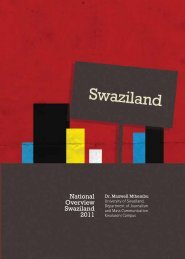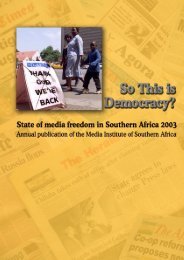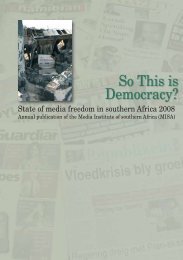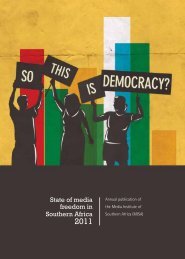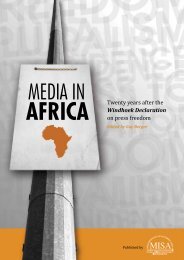- Page 1 and 2: So This Is Democracy?Report on the
- Page 3 and 4: AcknowledgementsThis publication re
- Page 5 and 6: ContentsState of media freedom and
- Page 7 and 8: Notes on ClassificationThe list and
- Page 9 and 10: Regional OverviewBy Zoé TitusSpeci
- Page 11 and 12: Media freedom statisticsThe total n
- Page 13 and 14: The bill lists a large number of it
- Page 15 and 16: Recea-se que o julgamento, possa ab
- Page 17 and 18: verdadeiramente privados, depois do
- Page 19 and 20: Regional OverviewBy Chilombo Mwonde
- Page 21: depression of African economies as
- Page 25 and 26: dos mídias e o tipo de artigos que
- Page 27 and 28: National OverviewBy Mário PaivaFre
- Page 29 and 30: anteed in the constitution. The mos
- Page 31 and 32: Oquadro geral político e legal dos
- Page 33 and 34: No mês de Abril o escritório de r
- Page 35 and 36: “It is clear that we are working
- Page 37 and 38: National OverviewBy Log Raditlhokwa
- Page 39 and 40: self-regulatory body and monitor th
- Page 41 and 42: Para a melhoria da qualidade da dem
- Page 43 and 44: políticos e os grupos das sociedad
- Page 45 and 46: · ALERTDate: October 28, 2005Perso
- Page 47 and 48: On August 31 2005, Tshepo Molwane,
- Page 49 and 50: deportation order after being decla
- Page 51 and 52: National OverviewBy Rethabile Pholo
- Page 53 and 54: interpretation in the absence of a
- Page 55 and 56: de uma nova claúsula que especific
- Page 57 and 58: · ALERTDate: November 11, 2005.Per
- Page 59 and 60: · ALERTDate: May 27, 2005.Persons/
- Page 61 and 62: National OverviewBy Levi Zeleza Man
- Page 63 and 64: and freedom of association. Section
- Page 65 and 66: Radio/TV Station Owner Classificati
- Page 67 and 68: Para os jornalistas e os mídias do
- Page 69 and 70: ConstituiçãoNão houve qualquer e
- Page 71 and 72: * ICR - Igreja Católica Romana* IC
- Page 73 and 74:
his lawyers to lodge an appeal with
- Page 75 and 76:
National OverviewBy Ericino de Sale
- Page 77 and 78:
Apart from these serious cases, the
- Page 79 and 80:
Em 2005, os midias massivos continu
- Page 81 and 82:
Moçambique realizou no mesmo ano (
- Page 83 and 84:
· ALERTDate: November 2005Persons/
- Page 85 and 86:
increase caused by this month’s 4
- Page 87 and 88:
National OverviewBy Willie OlivierL
- Page 89 and 90:
A few days later, National Assembly
- Page 91 and 92:
As a result, a licence for a second
- Page 93 and 94:
liberdade dos midias, os midias con
- Page 95 and 96:
Munyama, foi suspenso e acusado de
- Page 97 and 98:
National OverviewBy Paula FrayMedia
- Page 99 and 100:
and he smeared us in the process. A
- Page 101 and 102:
Opapel da magistratura e dos Mídia
- Page 103 and 104:
e o mundo.” Mathatha Tsedu, edito
- Page 105 and 106:
cians were interviewed and to deman
- Page 107 and 108:
National OverviewBy Vusi SibisiFree
- Page 109 and 110:
Parliamentary onslaughtIn February
- Page 111 and 112:
Houve muito poucas mudanças relati
- Page 113 and 114:
através da realização de cursos
- Page 115 and 116:
· ALERTDate: October 16, 2005Perso
- Page 117 and 118:
National OverviewBy Vusi SibisiFree
- Page 119 and 120:
The weak economic base of media own
- Page 121 and 122:
Antes de tomar conhecimento do esta
- Page 123 and 124:
Tanzânia terá o mecanismo regulad
- Page 125 and 126:
tigate the beating of a Bukuku, Kid
- Page 127 and 128:
National OverviewBy Elizabeth Mween
- Page 129 and 130:
“with intention to bring the repu
- Page 131 and 132:
Registaram-se violações contra a
- Page 133 and 134:
As secções 22 até 27 do acto, es
- Page 135 and 136:
· ALERTDate: December 19, 2005Pers
- Page 137 and 138:
· ALERTDate: July 25, 2005Persons/
- Page 139 and 140:
· ALERTDate: April 07, 2005Persons
- Page 141 and 142:
National OverviewBy MISA-ZimbabweZi
- Page 143 and 144:
tions as mandated under the various
- Page 145 and 146:
Article 19 of the International Con
- Page 147 and 148:
its network as stipulated in its li
- Page 149 and 150:
Todavia, as eleições de Março de
- Page 151 and 152:
Esta omissão por parte dos mídias
- Page 153 and 154:
Com a aprovação da proposta de le
- Page 155 and 156:
e-Mail e endereços residenciais à
- Page 157 and 158:
elatórios adversos sobre o ambient
- Page 159 and 160:
tinha sido capaz de prosseguir com
- Page 161 and 162:
ALERTDate: December 15, 2005Persons
- Page 163 and 164:
Date: September 06, 2005Persons/Ins
- Page 165 and 166:
communication of falsehoods, which
- Page 167 and 168:
Persons/Institutions: Toby Harnden,
- Page 169 and 170:
So This Is Democracy? 2005-169-Medi
- Page 171 and 172:
society and academia (e.g. human ri
- Page 173 and 174:
So This Is Democracy? 2005-173-Medi
- Page 175 and 176:
ANALYSIS:There are laws that interf
- Page 177 and 178:
Sector 2:The media landscape is cha
- Page 179 and 180:
SCORES:Individual scores: 1, 1, 1,
- Page 181 and 182:
2.12. Government does not use its p
- Page 183 and 184:
3.5 The public broadcaster is accou
- Page 185 and 186:
sists a trend among some journalist
- Page 187 and 188:
elation to rights and opportunities
- Page 189 and 190:
So This Is Democracy? 2005-189-Medi
- Page 191 and 192:
1.2. The right to freedom of expres
- Page 193 and 194:
1.7 Civil society in general and me
- Page 195 and 196:
SCORES:Individual scores: 2, 4, 4,
- Page 197 and 198:
SCORES:Individual scores: 1, 1, 3,
- Page 199 and 200:
ANALYSIS:According to the Broadcast
- Page 201 and 202:
3.6 Persons who have vested interes
- Page 203 and 204:
Generally, however, the Press Counc
- Page 205 and 206:
As a general rule, salaries for jou
- Page 207 and 208:
So This Is Democracy? 2005-207-Medi
- Page 209 and 210:
1.2. The right to freedom of expres
- Page 211 and 212:
SCORES:Individual scores: 2, 1, 2,
- Page 213 and 214:
sponsored by IBIS (Danish NGO); and
- Page 215 and 216:
2.10 Private media outlets operate
- Page 217 and 218:
SCORES:Individual scores: 1, 1, 1,
- Page 219 and 220:
3.9 The public broadcaster is techn
- Page 221 and 222:
There are some efforts under way to
- Page 223 and 224:
(ISPU). Training is also offered by
- Page 225 and 226:
So This Is Democracy? 2005-225-Medi
- Page 227 and 228:
The Namibian Broadcasting Corporati
- Page 229 and 230:
thing is that a public outcry must
- Page 231 and 232:
2.5 Community broadcasting enjoys s
- Page 233 and 234:
Although New Era is increasing its
- Page 235 and 236:
The NCC has a policy that requires
- Page 237 and 238:
addition, NBC is trying to make all
- Page 239 and 240:
SCORES:Individual scores: 3, 3, 2,
- Page 241 and 242:
Several organisations are offering
- Page 243 and 244:
So This Is Democracy? 2005-243-Medi
- Page 245 and 246:
1.2 The right to freedom of express
- Page 247 and 248:
There is no freedom of information
- Page 249 and 250:
in the past state police have confi
- Page 251 and 252:
2.7 Local and regional independent
- Page 253 and 254:
20 percent of the newspaper’s rev
- Page 255 and 256:
SCORES:Individual scores: 1, 1, 1,
- Page 257 and 258:
SBIS programming is generally diver
- Page 259 and 260:
never to be reported on negatively.
- Page 261 and 262:
pendently from the government syste
- Page 263 and 264:
So This Is Democracy? 2005-263-Medi
- Page 265 and 266:
SCORES:Individual scores: 3, 2, 3,
- Page 267 and 268:
1.7 Civil society in general and me
- Page 269 and 270:
Although the newspapers are a predo
- Page 271 and 272:
ANALYSIS:One view is that governmen
- Page 273 and 274:
Sector 3:Broadcasting regulation is
- Page 275 and 276:
SCORES:Individual scores: 1, 2, 1,
- Page 277 and 278:
Sector 4:The media practice high le
- Page 279 and 280:
Director and Editor-in-Chief, place
- Page 281 and 282:
editor who is not only the advisor
- Page 283 and 284:
.Breakdown by country / violationTo
- Page 285 and 286:
So This Is Democracy? 2005-285-Medi
- Page 287 and 288:
So This Is Democracy? 2005-287-Medi
- Page 289 and 290:
So This Is Democracy? 2005-289-Medi
- Page 291 and 292:
The 2005 winner of theMISA Press Fr
- Page 293 and 294:
case. Its team of journalists, espe
- Page 295 and 296:
How to report an attack on the medi
- Page 297 and 298:
About MISAMISA’s Mission, Vision
- Page 299 and 300:
1. Freedom of Expression and Right
- Page 301 and 302:
List of addresses of MISA ChaptersA
- Page 303 and 304:
Fax: 00 (260 1) 292096Resource Cent
- Page 305 and 306:
Appendices• Windhoek Declaration
- Page 307 and 308:
5. The world-wide trend towards dem
- Page 309 and 310:
African Charter on BroadcastingTher
- Page 311 and 312:
development agenda, and which is no
- Page 313 and 314:
Sector 3 Broadcasting regulation is
- Page 315 and 316:
Declaration of Principles on Freedo
- Page 317 and 318:
VPrivate Broadcasting1. States shal
- Page 319 and 320:
unless there is a real risk of harm



